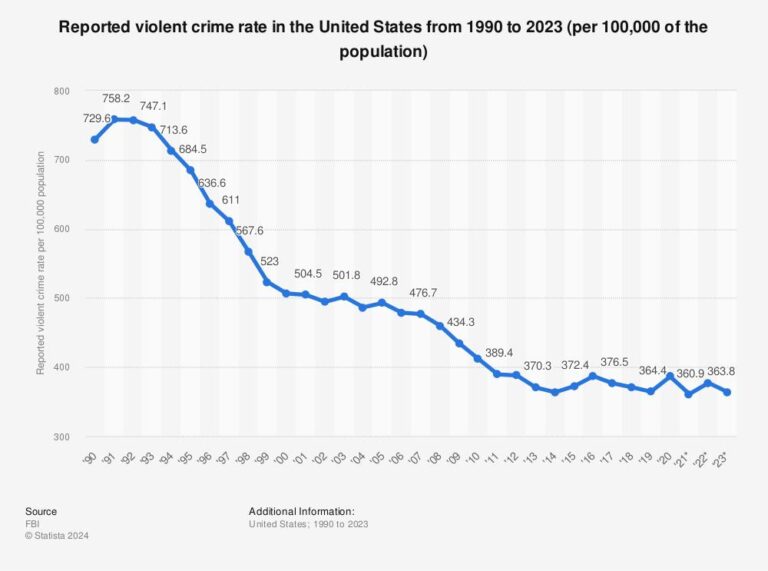In a significant shift for public safety, violent crime in the United States is experiencing a rapid decline, offering a glimmer of hope amid years of concern over rising violence. Recent data reveals that numerous cities across the country are reporting notable reductions in homicides, highlighting changing trends in urban crime patterns. This article explores which metropolitan areas are leading the way in curbing deadly violence and examines the factors contributing to these promising developments.
Violent Crime Trends Show Significant Declines Across Major US Cities
Recent statistics reveal a remarkable downturn in violent crime rates across several major U.S. cities, signaling positive progress in community safety initiatives. Cities such as Chicago, New York, and Los Angeles have reported substantial reductions in homicide rates compared to previous years. Experts attribute these improvements to a combination of enhanced policing strategies, community engagement programs, and increased investments in social services targeting at-risk populations. This downward trend also reflects advancements in technology and data-driven approaches employed by law enforcement agencies to proactively address potential threats.
Key cities exhibiting the most notable declines include:
- New York City: 12% drop in homicides compared to last year
- Chicago: A 15% decrease in violent crime incidents
- Los Angeles: Homicides down by 10%, with a significant plunge in gang-related violence
- Houston: Marked improvements in overall crime rates, particularly in urban neighborhoods
| City | Homicide Rate Decline | Major Initiative |
|---|---|---|
| New York City | 12% | Community Policing & CCTV Expansion |
| Chicago | 15% | Violence Interruption Programs |
| Los Angeles | 10% | Gang Violence Prevention Taskforce |
| Houston | 8% | Neighborhood Revitalization Projects |
Cities Leading the Drop in Homicide Rates Reveal Key Community Strategies
Across the nation, several cities have showcased remarkable success in reducing homicide rates, thanks to targeted community engagement and innovative policing strategies. From grassroots neighborhood watch programs to expanded youth outreach initiatives, these urban centers emphasize collaboration between law enforcement and residents, fostering trust and ensuring rapid response to conflicts before they escalate to violence. Additionally, investments in mental health services and economic opportunities have played a critical role in addressing the root causes of violent crime.
Key strategies adopted by these cities include:
- Community-led conflict resolution workshops
- Increased presence of peer mediators in high-risk neighborhoods
- Enhanced data-driven policing tactics
- Strategic partnerships with local nonprofits and schools
| City | Homicide Rate Drop (2023) | Primary Strategy |
|---|---|---|
| Detroit, MI | 27% | Youth Outreach & Job Training |
| Boston, MA | 22% | Community Policing & Mediation |
| Portland, OR | 19% | Data-Driven Policing |
| Atlanta, GA | 24% | Peer Conflict Resolution |
Analyzing the Factors Behind Safer Streets and Reduced Violence
Several critical elements have contributed to the notable decrease in violent crime rates across numerous urban areas. Many cities have embraced innovative community policing strategies, fostering stronger relationships between law enforcement and residents. This approach has not only improved trust but also increased the reporting and prevention of criminal activities. Additionally, targeted investments in youth programs and economic development have provided at-risk populations with constructive alternatives, diminishing the appeal and necessity of gang involvement and criminal behavior.
Urban revitalization has also played a significant role. Improvements in public infrastructure, such as better street lighting, surveillance technology, and the cleaning of neglected spaces, have made high-crime areas less accessible and more monitored. City officials emphasize multidimensional approaches, highlighting that no single factor explains the decline but rather a combination of policies tailored to address local challenges.
- Community-focused policing
- Investment in social services and education
- Enhanced urban infrastructure and environmental design
- Data-driven crime prevention tactics
| City | Homicide Rate Drop (%) | Key Initiative |
|---|---|---|
| Baltimore | 25% | Community Liaison Officers |
| Chicago | 22% | Youth Employment Programs |
| New York City | 18% | Enhanced Surveillance Systems |
Policy Recommendations to Sustain and Accelerate Crime Reduction Efforts
To ensure continued success in reducing violent crime, especially homicides, cities must prioritize community-oriented policing coupled with investment in social programs. Enhanced collaboration between law enforcement and local organizations fosters trust and facilitates the identification of root causes driving crime rates. Policymakers should also focus on expanding mental health and addiction services, recognizing their critical role in preventing violence before it starts. Sustainable funding for educational initiatives that provide career pathways and life skills to at-risk youth can significantly decrease the allure of criminal activity.
Moreover, data-driven strategies are essential to maintain momentum. The adoption of real-time crime mapping and predictive analytics allows for smarter resource allocation and timely interventions. Cities demonstrating declines in violent crime often implement multi-agency task forces addressing specific regional challenges such as gun trafficking and gang violence. Below is a sample framework of recommended actions:
- Community Engagement: Increase neighborhood forums and citizen-police advisory boards
- Prevention Programs: Expand access to youth mentorship and employment opportunities
- Technology Utilization: Implement AI-driven crime forecasting tools
- Interagency Coordination: Create joint operations between law enforcement, social services, and public health
| Policy Area | Recommended Action | Expected Impact |
|---|---|---|
| Community Trust | Regular public dialogues with officers | Improved reporting & cooperation |
| Youth Intervention | Expand after-school programs | Reduced juvenile offenses |
| Data Analytics | Deploy predictive policing software | Targeted crime prevention |
| Multi-Agency Collaboration | Integrated task forces | Enhanced case resolution |
Final Thoughts
As violent crime rates continue their significant decline across the nation, the cities highlighted in this report offer promising examples of progress in public safety. While challenges remain, the downward trend in homicides signals a positive shift that could serve as a model for other communities striving to enhance security. Continued efforts from law enforcement, policymakers, and residents alike will be crucial to maintaining and building upon these gains in the years ahead.




